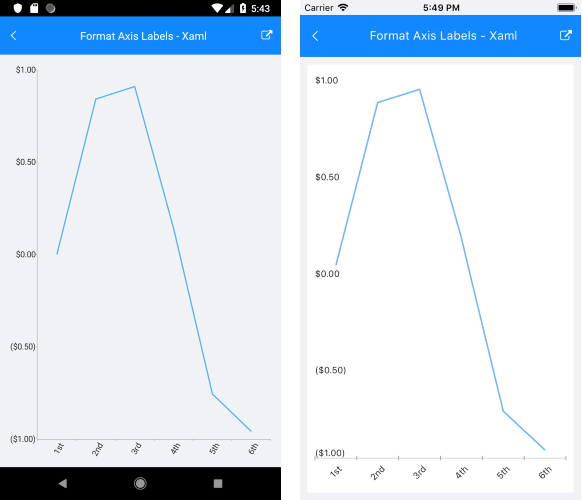.NET MAUI Chart DateTime Continuous Axis
The DateTime Continuous Axis is a special axis that extends the base CartesianAxis class and is a hybrid between a categorical and a numerical axis. DateTimeContinuousAxis works with categorical data but instead of categories, the axis builds time slots depending on its Minimum, Maximum, and MajorStep values.
The DateTime Continuous Axis also expects valid DateTime values so that the data can be plotted correctly. The DateTimeContinuousAxis is a timeline where each data point has a position depending on its DateTime value. The timeline range properties are automatically calculated if not set explicitly by the user: the default value of the major step is the smallest difference between any two DateTime values. As the axis behaves like a numerical axis, it can have empty slots if no data is available for these slots.
The CategoricalAxis inherits from the base Axis class. For more information, refer to the article on inherited properties.
Features
The DateTime Continuous Axis exposes the following properties:
-
Minimum—Defines the start value of the timeline. SpecifyDateTime.Minimumto clear the value and force the axis to determine it automatically, depending on the smallest presentDateTimevalue. -
Maximum—Defines the end value of the timeline. SpecifyDateTime.Maximumto clear the value and force the axis to determine it automatically, depending on the greatest presentDateTimevalue. -
PlotMode—Defines the strategy that is used to position data points along the axis time slots. The available options are{ BetweenTicks, OnTicks }. -
MajorStep—Defines the user-defined step between two adjacent time slots. Specifydouble.PositiveInfinityto clear the value and make the axis calculate an automatic step, depending on the smallest difference between any two dates. -
MajorStepUnit—Defines whatDateTimecomponent to which theMajorStepproperty refers ({ Year, Quarter, Month, Week, Day, Hour, Minute, Second, Millisecond }). -
GapLength—Defines the distance (in logical units [0,1]) between two adjacent time slots. The default value is0.3. As an example, if you have two Bar Series combined in the Cluster mode, you can remove the space between the bars by setting theGapLengthproperty to0.
Example
The following example shows how to format the axis labels on the DateTime Continuous Axis:
1. Create the needed business objects:
public class TemporalData
{
public DateTime Date { get; set; }
public double Value { get; set; }
}
2. Create a ViewModel:
public class ViewModel
{
public ObservableCollection<TemporalData> Data { get; set; }
public ViewModel()
{
this.Data = GetDateTimeData(6);
}
private static ObservableCollection<TemporalData> GetDateTimeData(int itemsCount)
{
var startDate = new DateTime(2015, 03, 01);
ObservableCollection<TemporalData> items = new ObservableCollection<TemporalData>();
for (int i = 0; i < itemsCount; i++)
{
TemporalData data = new TemporalData();
data.Date = startDate.AddDays(i);
data.Value = Math.Sin(i);
items.Add(data);
}
return items;
}
}
3. Create a class, for example, DateLabelFormatter that inherits from LabelFormatterBase<DateTime> for the DateTime Continuous Axis.
public class DateLabelFormatter : LabelFormatterBase<DateTime>
{
public override string FormatTypedValue(DateTime value)
{
if (value.Day == 1)
{
return value.Day + "st";
}
else if (value.Day == 2)
{
return value.Day + "nd";
}
else if (value.Day == 3)
{
return value.Day + "rd";
}
else
{
return value.Day + "th";
}
}
}
4. Use the following snippet to declare the RadChart in XAML :
<telerik:RadCartesianChart>
<telerik:RadCartesianChart.BindingContext>
<local:ViewModel />
</telerik:RadCartesianChart.BindingContext>
<telerik:RadCartesianChart.HorizontalAxis>
<telerik:DateTimeContinuousAxis LabelFitMode="Rotate"
MajorStepUnit="Day">
<telerik:DateTimeContinuousAxis.LabelFormatter>
<local:DateLabelFormatter />
</telerik:DateTimeContinuousAxis.LabelFormatter>
</telerik:DateTimeContinuousAxis>
</telerik:RadCartesianChart.HorizontalAxis>
<telerik:RadCartesianChart.VerticalAxis>
<telerik:NumericalAxis LabelFormat="C"
MajorStep="0.5"
Minimum="-1"
Maximum="1" />
</telerik:RadCartesianChart.VerticalAxis>
<telerik:RadCartesianChart.Series>
<telerik:LineSeries ItemsSource="{Binding Data}"
CategoryBinding="Date"
ValueBinding="Value" />
</telerik:RadCartesianChart.Series>
</telerik:RadCartesianChart>
Formatter looks:
